A long-time friend of mine has always refused to run with the crowd. Rather than having the usual rifles in 223 Remington and 22-250 for bumping off varmints, his favorite rifles are in 222 Remington and 220 Swift. Whereas I often hunt deer with a rifle in 243 Winchester, he said his rifle in 6mm Remington is a better choice. Despite the fact that my Remington Model 7 in 7mm-08 has proven to be a great little deer rifle, he said his Ruger Model 77 in 7x57mm Mauser kills them “noticeably deader.” His favorite .30-caliber magnum? If you guessed 300 Holland & Holland, you are correct. While examining my custom rifle in 35 Whelen on a ’98 Mauser action several years ago, he asked about other possible alternatives in its performance range, so I mentioned the 350 Remington Magnum.
A few months thereafter, the picky fellow showed up at my house with a custom rifle he had bought on an online auction. The rifle had an FN Mauser action and Montana barrelmaker, William Hobaugh, had installed the barrel and chambered it for the 35-284 wildcat. It’s a very nice stock of tiger tail maple made by Hal Hartley of Lenoir, North Carolina. It has a Lyman All-American scope in 3x magnification held in place by a Pachmayr Lo-Swing mount. A custom die set made by RCBS was also included. The rifle had already enjoyed years of use when it was purchased and yet, its condition indicated an abundance of loving care. My offer to assist in developing a load for an upcoming spring bear hunt was quickly accepted.
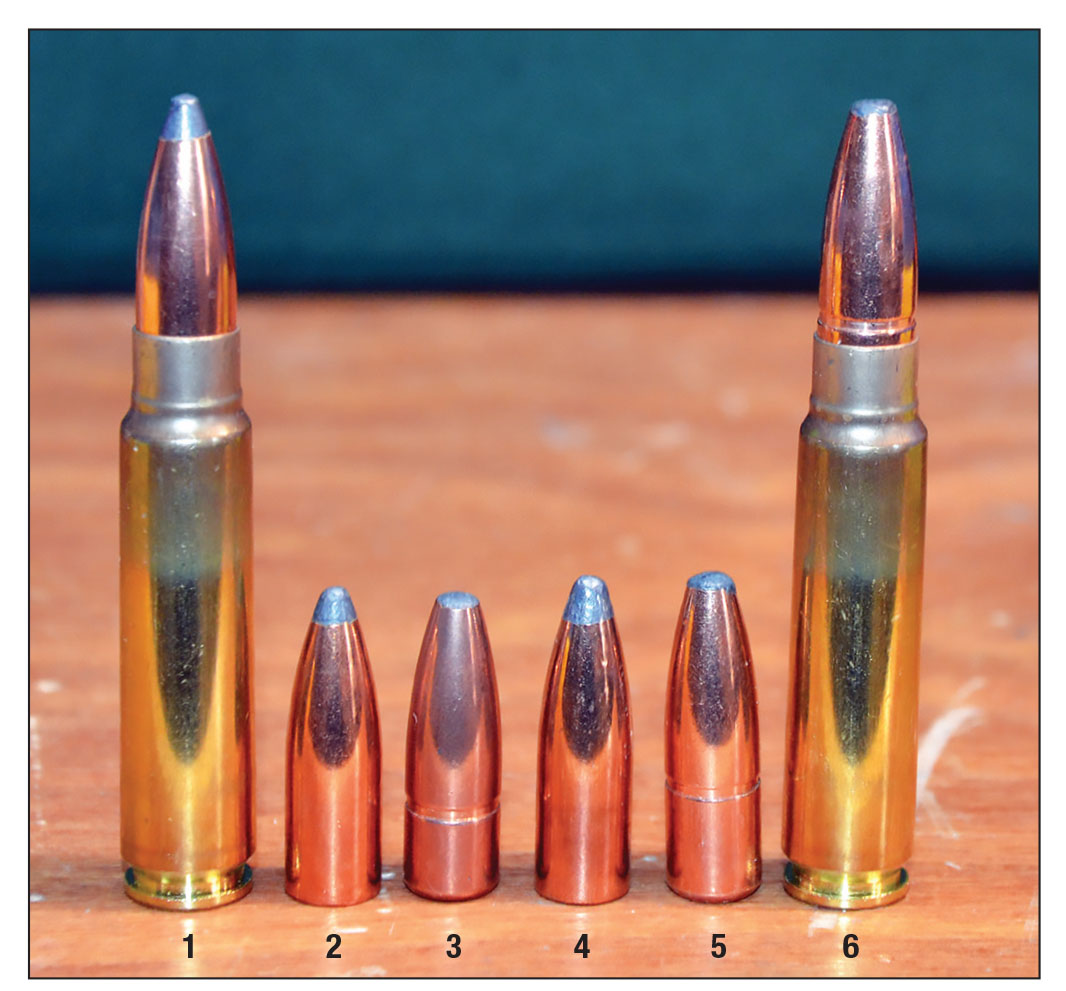
Great bullets for taking any game for which the 35-284 is suitable: (1) 35-284 loaded with Nosler 225-grain Partition, (2) Nosler 225-grain Partition, (3) Swift 225-grain A-Frame, (4) Speer 250-grain SPHC, (5) Swift 250-grain A-Frame and (6) 35-284 loaded with Swift 250-grain A-Frame.
To understand why someone would have a rifle with a standard-length action built in 35-284 rather than 35 Whelen, we will have to flip the calendar back a few decades. Winchester introduced the 284 in 1963, and soon thereafter, eager wildcatters across the country shouted out with glee as they pounced on the new case and necked it both up and down for a variety of bullet diameters. The 6mm-284 became the most popular but there were a number of others, and all received their share of praise in various shooting and hunting publications. The excitement and enthusiasm were enough to keep gunsmiths and chamber reamer makers busy for quite a long time. As best as we could determine, my friend’s rifle was built sometime during the 1960s. At that time, new wildcats on the 284 Winchester case were hot, while an old wildcat based on the 35 Whelen was not.
When forming cases for the rifle, I first applied Imperial Sizing Die Wax to the interior of case necks and then ran them through an RCBS neck expander die with a 22 to 30 expander installed. After reapplying the sizing wax, the case necks were opened up with a 30 to 35 expander. After a trip through the RCBS full-length resizing die, the cases were trimmed to a length of 2.140 inches. (Imperial Sizing Die wax is now available from Redding and Hornady offers a similar product.)
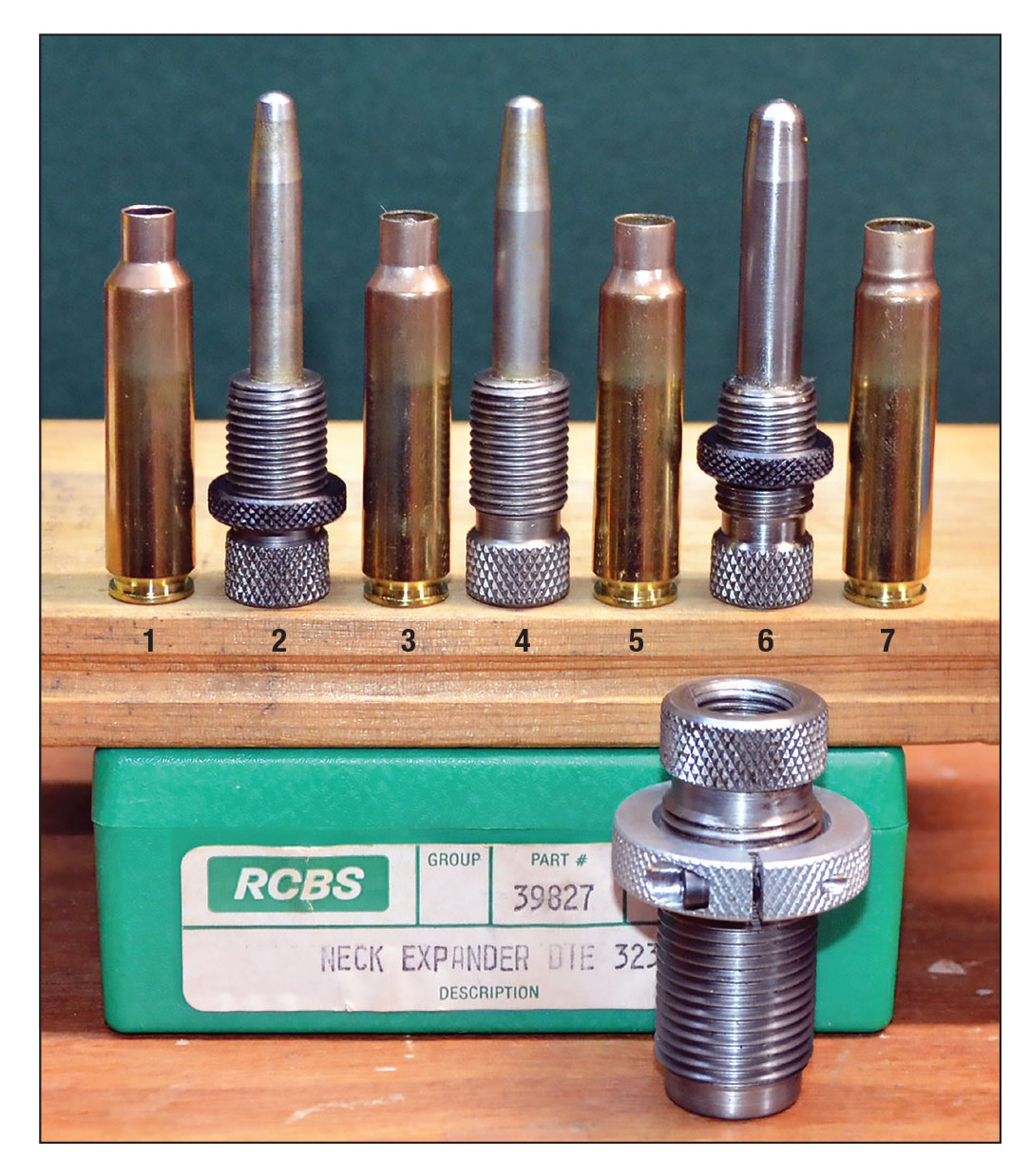
When Layne developed loads for a rifle in 35-284 belonging to a friend, 284 cases were readily available from Winchester. The case was formed by first expanding necks with an RCBS 22 to 30 expander, followed by a 30 to 35 expander. In the absence of 284 Winchester cases, 35-284 cases can be formed from 6.5-284 brass, using a third expander. The expander die is shown here at the front of the die box and up top: (1) Lapua 6.5-284 case, (2) 22 to 7mm expander, (3) Case neck expanded to 7mm, (4) 22 to 30 expander, (5) Case neck expanded to 30, (6) 30 to 35 expander and (7) case neck expanded to 35.
First on the agenda was a comparison of powder capacities. The chamber throat of the rifle allowed the Swift 250-grain A-Frame to be seated for a cartridge length of 3 inches. The bullet free-traveled .015 inch prior to engaging the rifling and its base rested flush with the shoulder-neck juncture of the case for zero encroachment on its powder cavity. With the Swift bullet seated in Remington 35 Whelen cases for an overall length of 3.340 inches and .150 inch of jump, its base was positioned .200 inch forward of the shoulder. After Swift 250-grain A-Frame bullets were seated in virgin unprimed cases, both were weighed. Then, a hypodermic syringe with a needle small enough to reach through the flash holes of the cases was used to fill their empty spaces with water and they were weighed again. Average net capacities were 58.6 grains for the 35 Whelen and 59.4 grains for the 35-284. This allowed pressure-tested starting loads for the 35 Whelen published in various reliable sources to be safely used in the 35-284. All things including barrel length and the pressure to which the two cartridges are loaded being equal, maximum velocities should be the same or close to it anyhow.
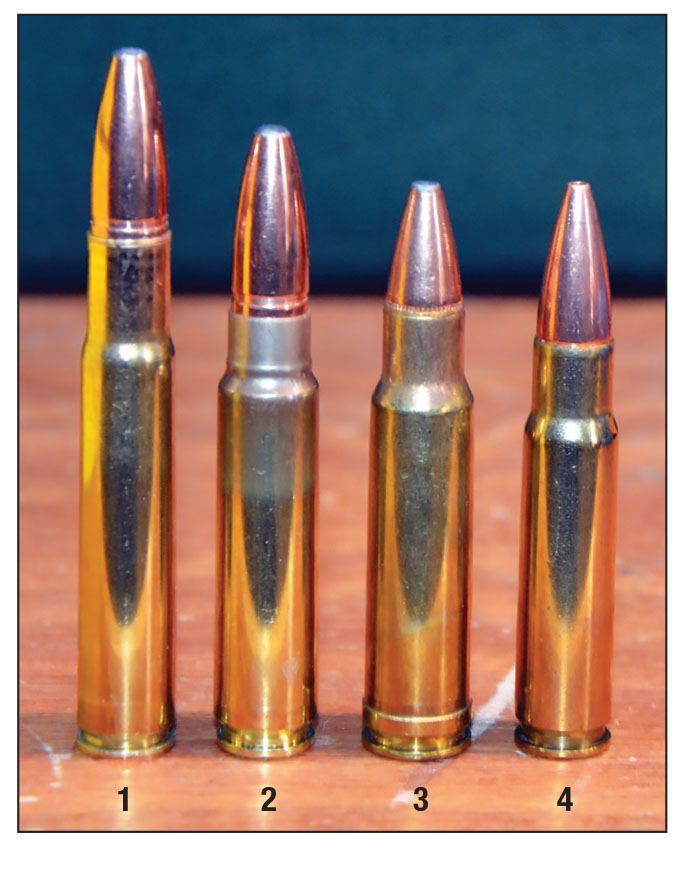
The 35-284 with its competition: (1) 35 Whelen, (2) 35-284, (3) 350 Remington Magnum and (4) 358 Winchester.
The owner of the rifle in 35-284 had no interest in bullets weighing less than 225 grains so I stayed that course when developing handloads. I would like to have tried the Nosler 250-grain Partition and the Hornady Interlock of the same weight but they were not on hand. Both deliver excellent accuracy from my custom Mauser in 35 Whelen.
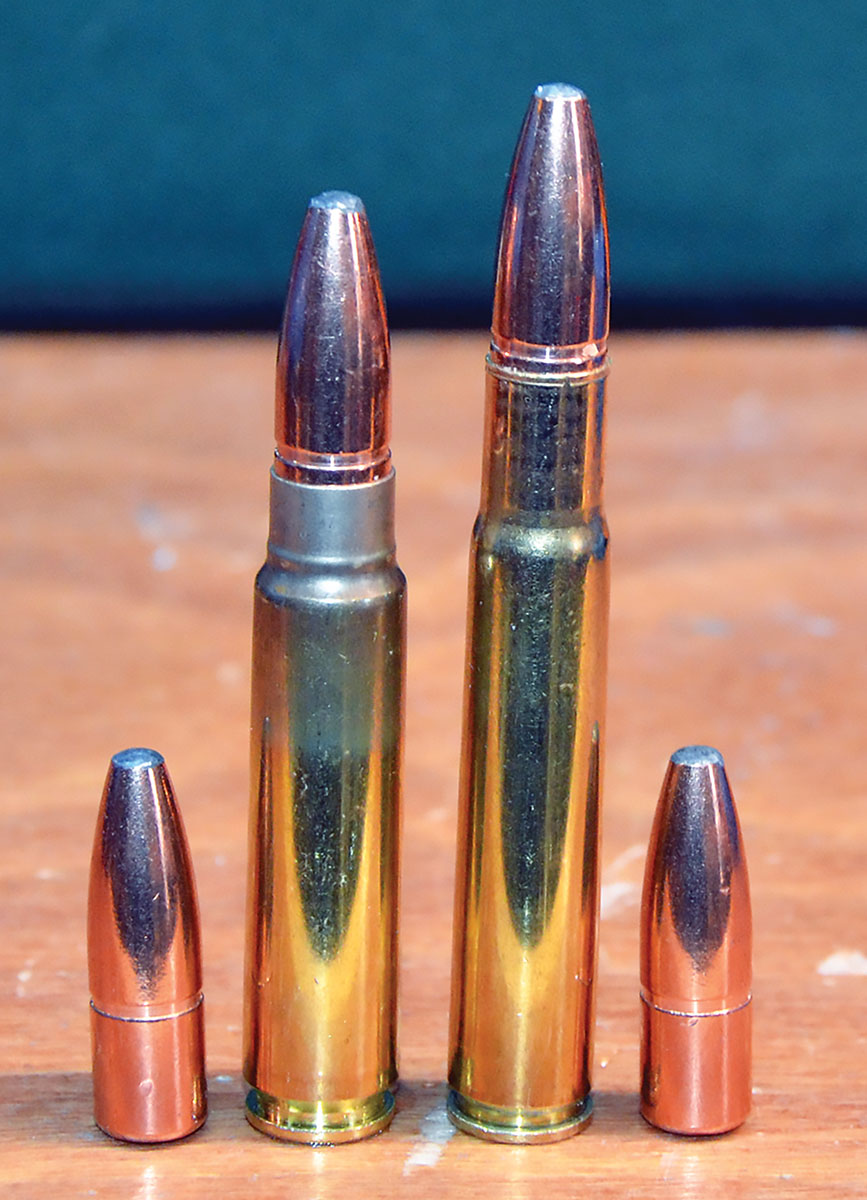
With the Swift 250-grain A-frame bullet seated to cartridge lengths of 3 inches in the 35-284 and 3.340 inches in the 35 Whelen, there is less than 1 grain of water difference in their net capacities. This allowed pressure-tested loads published in various reliable sources for the 35 Whelen to be safely used in the 35-284.
Graf & Sons usually has 284 Winchester cases made by Peterson Cartridge in stock. If, by chance they are not, 6.5-284 cases made by Lapua and Hornady are options. Simply begin the necking-up process with a 22 to 7mm expander from RCBS and then follow with the two expanders used when beginning with the 284 Winchester case. I have not tried the Peterson brass but the capacity of 35-284 cases formed from Lapua 6.5-284 brass is about 1 grain more than for 284 brass made by Winchester and 1.5 grains more than when formed from Hornady 6.5-284 brass.
For the benefit of those who are interested in building a rifle in 35-284 on a short action such as the Remington Model 700 or Model 7, I will mention that seating the Swift 250-grain A-Frame to an overall cartridge length of 2.8 inches reduces the useable capacity of the case to 54.2 grains of water or about 5 grains less than when seating that bullet to a cartridge length of 3 inches. This would require a reduction of published starting loads for the 35 Whelen and while maximum velocity would also be reduced, I doubt if it would be by more than 100 feet per second.
The Swift and Nosler 225-grain bullets are shorter and when seated to a cartridge length of 2.8 inches for a short action they only slightly enter the powder space of the case. For this reason, velocity of those bullets from a short-action rifle in 35-284 with its chamber throated for them should not be too far behind the 35 Whelen. Either bullet would handle game up to the size of moose and elk quite nicely. Add the Nosler 200-grain AccuBond or Hornady FTX of the same weight to the quiver and no deer standing inside 300 yards would be safe.
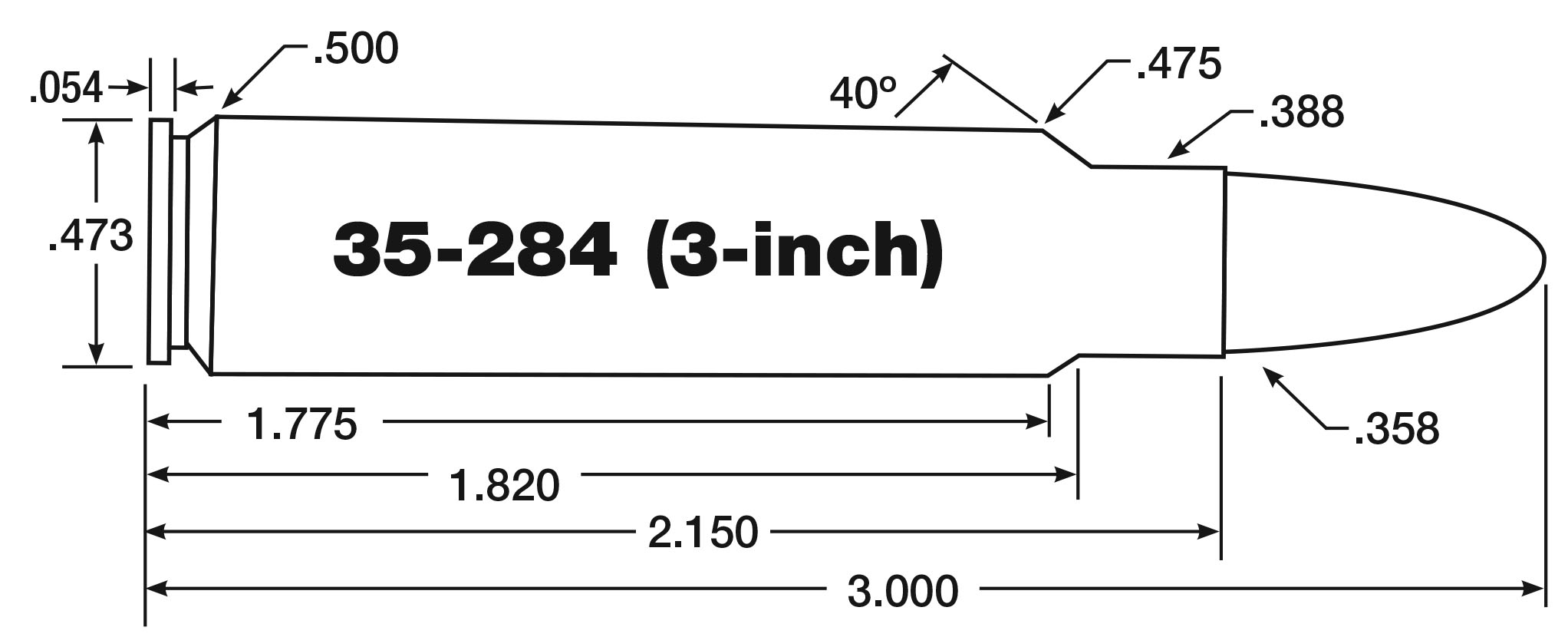




.jpg)


